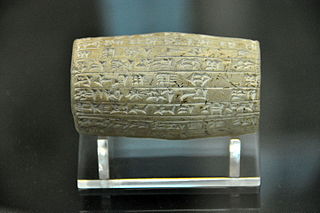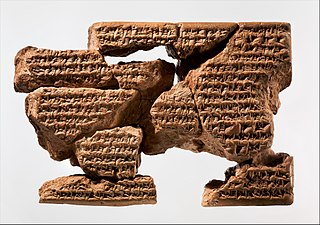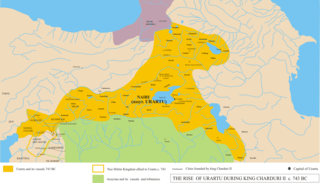Related Research Articles

Chaldea was a small country that existed between the late 10th or early 9th and mid-6th centuries BC, after which the country and its people were absorbed and assimilated into the indigenous population of Babylonia. Semitic-speaking, it was located in the marshy land of the far southeastern corner of Mesopotamia and briefly came to rule Babylon. The Hebrew Bible uses the term כשדים (Kaśdim) and this is translated as Chaldaeans in the Greek Old Testament, although there is some dispute as to whether Kasdim in fact means Chaldean or refers to the south Mesopotamian Kaldu.
The 6th century BC started on the first day of 600 BC and ended on the last day of 501 BC.

The 7th century BC began the first day of 700 BC and ended the last day of 601 BC.

Babylonia was an ancient Akkadian-speaking state and cultural area based in the city of Babylon in central-southern Mesopotamia. It emerged as an Akkadian populated but Amorite-ruled state c. 1894 BC. During the reign of Hammurabi and afterwards, Babylonia was retrospectively called "the country of Akkad", a deliberate archaism in reference to the previous glory of the Akkadian Empire. It was often involved in rivalry with the older ethno-linguistically related state of Assyria in the north of Mesopotamia and Elam to the east in Ancient Iran. Babylonia briefly became the major power in the region after Hammurabi created a short-lived empire, succeeding the earlier Akkadian Empire, Third Dynasty of Ur, and Old Assyrian Empire. The Babylonian Empire rapidly fell apart after the death of Hammurabi and reverted to a small kingdom centered around the city of Babylon.
The year 612 BC was a year of the pre-Julian Roman calendar. In the Roman Empire, it was known as year 142 Ab urbe condita. The denomination 612 BC for this year has been used since the early medieval period, when the Anno Domini calendar era became the prevalent method in Europe for naming years.

Nabopolassar was the founder and first king of the Neo-Babylonian Empire, ruling from his coronation as king of Babylon in 626 BC to his death in 605 BC. Though initially only aimed at restoring and securing the independence of Babylonia, Nabopolassar's uprising against the Neo-Assyrian Empire, which had ruled Babylonia for more than a century, eventually led to the complete destruction of the Assyrian Empire and the rise of the Neo-Babylonian Empire in its place.

Sîn-šar-iškun was the penultimate king of Assyria, reigning from the death of his brother and predecessor Aššur-etil-ilāni in 627 BC to his own death at the Fall of Nineveh in 612 BC.

Cyaxares was the third king of the Medes. He ascended to the throne in 625 BCE, after his father Phraortes lost his life in a battle against the Assyrians.

The Battle of Nineveh is conventionally dated between 613 and 611 BC, with 612 BC being the most supported date. Rebelling against the Assyrians, an allied army which combined the forces of Medes and the Babylonians besieged Nineveh and sacked 750 hectares of what was, at that time, one of the greatest cities in the world. The fall of Nineveh led to the destruction of the Neo-Assyrian Empire over the next three years as the dominant state in the Ancient Near East. Archeological records show that the capital of the once mighty Assyrian Empire was extensively de-urbanized and depopulated in the decades and centuries following the battle. A garbled account of the fall of the city later led to the story of the legendary king Sardanapalus.
The Fall of Harran refers to the siege and capture of the Assyrian city of Harran by the Median and Neo-Babylonian empires.

The Revolt of Babylon in 626 BC refers to the revolt of the general Nabopolassar and his war of independence until he successfully consolidated control of Babylonia in 620 BC, defeating the Neo-Assyrian Empire which had ruled Babylonia for more than a century. The revolt saw the formation of the Neo-Babylonian Empire and was one of the key factors contributing to the fall of Assyria; twenty years after the revolt had begun, Nabopolassar's army and that of his ally, Cyaxares of the Medes, had destroyed the Neo-Assyrian Empire.

The Urartu–Assyria War was a conflict between the Kingdom of Urartu and the Neo-Assyrian Empire. The war began around 714 BC, with the invasion of Urartu by the Assyrian King Sargon II. Sargon led multiple offensives deep into Urartian territory, amassing numerous victories in the war. Following his death, however, Urartian Kings Argishti II and Rusa II launched many successful counterattacks, reclaiming Urartu's lost territory and gaining some from Assyria. However, their successors suffered multiple major defeats, resulting in Urartu becoming an Assyrian client state.
Aššur-uballiṭ II, also spelled Assur-uballit II and Ashuruballit II, was the final ruler of Assyria, ruling from his predecessor Sîn-šar-iškun's death at the Fall of Nineveh in 612 BC to his own defeat at Harran in 609 BC. He was possibly the son of Sîn-šar-iškun and likely the same person as a crown prince mentioned in inscriptions at the Assyrian capital of Nineveh in 626 and 623 BC.

The timeline of ancient Assyria can be broken down into three main eras: the Old Assyrian period, Middle Assyrian Empire, and Neo-Assyrian Empire. Modern scholars typically also recognize an Early period preceding the Old Assyrian period and a post-imperial period succeeding the Neo-Assyrian period.

The Sargonid dynasty was the final ruling dynasty of Assyria, ruling as kings of Assyria during the Neo-Assyrian Empire for just over a century from the ascent of Sargon II in 722 BC to the fall of Assyria in 609 BC. Although Assyria would ultimately fall during their rule, the Sargonid dynasty ruled the country during the apex of its power and Sargon II's three immediate successors Sennacherib, Esarhaddon and Ashurbanipal are generally regarded as three of the greatest Assyrian monarchs. Though the dynasty encompasses seven Assyrian kings, two vassal kings in Babylonia and numerous princes and princesses, the term Sargonids is sometimes used solely for Sennacherib, Esarhaddon and Ashurbanipal.

The Medo-Babylonian conquest of the Assyrian Empire was the last war fought by the Neo-Assyrian Empire, between 626 and 609 BC. Succeeding his brother Ashur-etil-ilani, the new king of Assyria, Sinsharishkun, immediately faced the revolt of one of his brother's chief generals, Sin-shumu-lishir, who attempted to usurp the throne for himself. Though this threat was dealt with relatively quickly, the instability caused by the brief civil war may have made it possible for another official or general, Nabopolassar, to rise up and seize power in Babylonia. Sinsharishkun's inability to defeat Nabopolassar, despite repeated attempts over the course of several years, allowed Nabopolassar to consolidate power and form the Neo-Babylonian Empire, restoring Babylonian independence after more than a century of Assyrian rule. The Neo-Babylonian Empire, and the newly-formed Median Empire under King Cyaxares, then invaded the Assyrian heartland. In 614 BC, the Medes captured and sacked Assur, the ceremonial and religious heart of the Assyrian Empire, and in 612 BC, their combined armies attacked and razed Nineveh, the Assyrian capital. Sinsharishkun's fate is unknown but it is assumed that he died in the defense of his capital. He was succeeded as king only by Ashur-uballit II, possibly his son, who rallied what remained of the Assyrian army at the city of Harran and, bolstered by an alliance with Egypt, ruled for three years, in a last attempt to resist the Medo-Babylonian invasion of his realm.
After the death of Assurbanipal in 631 BC, the Neo-Assyrian Empire entered a period of instability. This was the moment when the Babylonian ruler, Nabopolassar, led a revolt against Assyrian rule. After a few years of war, the Babylonians expelled the Assyrian forces from their territory.
After the death of Assurbanipal in 627 BC, the Neo-Assyrian empire entered a period of instability caused by fighting between Sin-shar-ishkun and his brother Assur-etil-ilani. In 626 BC, Nabopolassar, the Babylonian ruler revolted against the Assyrians. After a few years of war, the Babylonians expelled the Assyrian forces from their territory. However, Nabopolassar could not bring the fight to the heartland of the Assyrian empire. The situation changed drastically in 616 BC, when the Medes attacked the Assyrian empire. The fall of Tarbiṣu occurred when the Median army, led by Cyaxares, attacked and conquered the city. In the aftermath, the Medes went further and decisively defeated the Assyrians at the battle of Assur.

The Assyrian conquest of Egypt covered a relatively short period of the Neo-Assyrian Empire from 673 to 663 BCE. The conquest of Egypt not only placed a land of great cultural prestige under Assyrian rule but also brought the Neo-Assyrian Empire to its greatest extent.
References
- ↑ "What Were the Largest Cities Throughout History?". Archived from the original on 2016-08-18. Retrieved 2006-03-01.